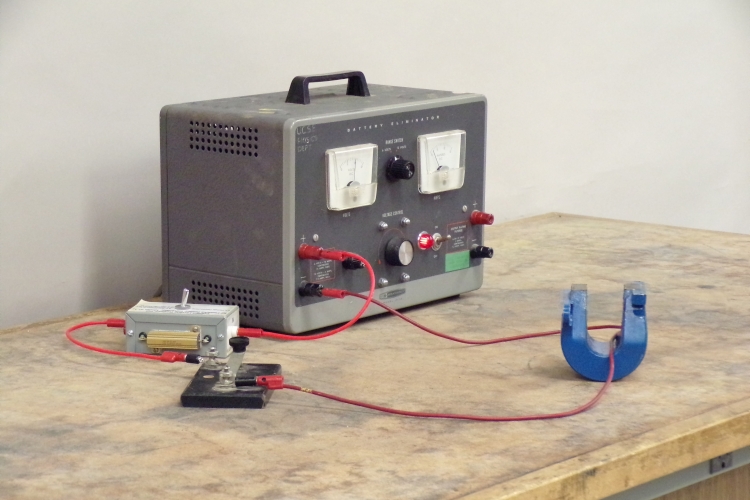
Turn on the power supply, and press the tap switch. The wire jumps from between the poles of the U magnet (north is on the right in the photograph). Rotate the magnet 180 degrees to exchange the poles, replace the wire, and press the tap switch. The wire now remains in place.
An electric charge passing through a magnetic field experiences a (sideways) force, F = qv × B, where q is the magnitude of the charge, v is its velocity, and B is the magnetic field. The magnitude of the the force is qvB sin θ, where θ is the angle between v and B. When the charge is traveling parallel to the magnetic field, then, this force is zero, and when v is perpendicular to B, it is maximum (F = qvB). If the charge is part of a current, i, flowing in a wire, then the wire feels a force of F = il × B, where l is the length of the part of the wire that is in the magnetic field. (For simplicity, we are assuming that this part of the wire is straight.) If the wire is perpendicular to the magnetic field, this force is F = ilB.
The wire in this demonstration is connected across the power supply output, in series with a tap switch (and a current-limiting resistor), and sits in the bottom of a U magnet. Between the poles of a U magnet, which is like a bar magnet that has been bent into a U shape, the field lines run across the space between the poles, perpendicular to their surfaces. They leave the north pole of the magnet and enter the south pole, and between the arms of the U, they run straight from the north arm to the south arm. The wire sitting at the bottom of the U magnet runs perpendicular to the magnetic field. By convention, current refers to the flow of positive charge, so when you close the tap switch, current flows from the switch through the wire and back into the power supply. In the section of the wire that is sitting in the U magnet, then, the current flows toward the back of the photograph. As noted in the caption of the photograph, the north pole of the magnet is on the right, so B points toward the left. Since l points into the photograph and B points to the left, their cross product, F, points upward, and the wire jumps out of the magnet. If we consider electron flow, we see that v now points out of the photograph, but since q is now negative, qv × B still points upward (and so does il × B), and the wire still jumps out of the magnet.
If you now rotate the magnet 180 degrees, the north pole is now on the left, and B now points to the right. If you replace the wire in the bottom of the magnet, but do not change how it is connected to the power supply, when you close the tap switch the current still flows into the photograph. qv × B and il × B now point downward. Since the wire is at the bottom of the magnet opening, it merely sits there.
References:
1) David Halliday and Robert Resnick. Physics, Part Two, Third Edition (New York: John Wiley and Sons, Inc., 1978), pp. 718-22.